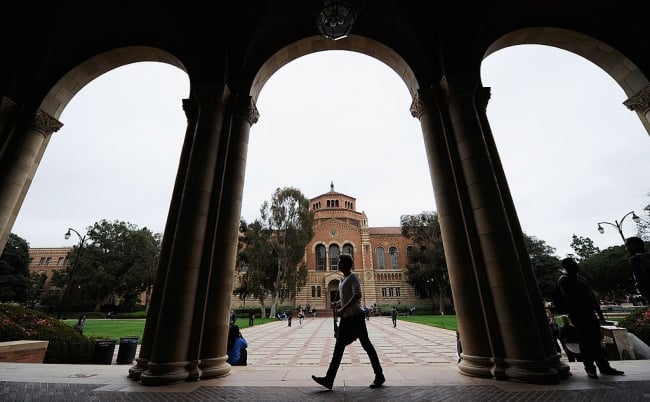You have /5 articles left.
Sign up for a free account or log in.

Kevork Djansezian/Getty Images
The COVID-19 pandemic has ushered in waves of layoffs and furloughs in higher education. While adjunct faculty and other academic workers have been affected, employees who work in nonacademic and nonadministrative roles, such as dining and custodial services, have been particularly targeted by cost-cutting measures.
At Rutgers University, for example, which is holding most classes online this semester, more than 500 dining workers have been laid off.
The University of Massachusetts at Amherst has indefinitely furloughed 850 staff members, mostly in housing and dining services.
Universities and state governments are surely facing budget shortfalls due to losses in tuition, room and board, and other revenue streams. Rutgers, for example, adopted a budget this week that projects the university deficit at more than $97 million. Still, some in higher education have argued that universities could do more to protect the most vulnerable people who work for them.
Lower-paid, hourly staff are often targeted for layoffs because they have fewer job protections and are not seen as central to the academic mission, said Kevin McClure, a professor of higher education at the University of North Carolina Wilmington.
“Many institutions, when they are thinking about cost-cutting, are trying to protect what they see as being most essential to instruction,” McClure said. “Frankly, I think it’s the case that institutions view those people as more expendable.”
In other cases, those staff members may be directly employed by a third party, such as a dining services vendor.
“Those employees are largely outside of the university’s control and honestly that’s a huge reason why institutions outsource to begin with,” McClure said, “because effectively those labor decisions get outsourced to another company, and those institutions don’t have the same responsibility to the people who are working there.”
Workers on the lower end of the pay scale are often some of the most vulnerable on a college campus.
“Classified staff are often our lowest-paid employees on campus who may or may not receive benefits such as health benefits. Laying them off means that their incomes are cut off and so are any benefits that they may have received. During a pandemic, their release is dehumanizing,” said Dian Squire, a professor of higher education at Northern Arizona University, via email. “Classified staff tend to be disproportionately from Black, Indigenous and other communities of color. By laying off classified staff, universities betray their ‘commitments’ to diversity and inclusion and enact asymmetrical inequity on already marginalized populations.”
Some have argued that layoffs or furloughs at their institutions aren’t really necessary, but rather a matter of administrative convenience. The University of California has laid off or cut time from more than 400 workers in service and patient care. But the union that represents those workers has argued that those cuts weren’t necessary.
"I think it's honestly lazy choices," said Liz Perlman, executive director of the American Federation of State, County and Municipal Employees Local 3299. Research from the organization has suggested that the university system has $10 billion in unrestricted endowment funds the union believes it could use to cover costs. That research also suggested the university experienced a loss of over $1 billion in the spring.
The University of California has instead countered that its most recent data puts the value of its unrestricted reserves at $3.6 billion, not $10 billion, according to a spokesperson for the system. The financial impact of the pandemic, she said, from March through August, was approximately $2.2 billion.
[This article has been updated to include comments from representatives for the University of California system.]
In situations where layoffs have been necessary, most have been due to lack of on-campus work and occur primarily at campuses.
McClure said that universities generally have the power to use their unrestricted endowment funds to cover wages and prevent layoffs, but they are unlikely to do so.
“Making that case to a foundation board or a board of trustees is probably going to be difficult,” he said, “bearing in mind that many of those people are coming from the private sector, where it’s very normal in an economic downturn for a company to cut jobs and to lay people off.”
The University of California has argued that using its unrestricted endowment to avoid layoffs would have a negative effect on other areas of the university.
"Even when an endowment is unrestricted, the payout has almost always been allocated as part of UC’s budget process to support various activities, often for areas that had previously been supported by a donor or where state support may not have been as significant. These areas have included particular academic programs, student scholarships and fellowships, endowed chairs, and specific research initiatives," a spokesperson for the system said via email. "Any decision to redirect those funds to some other purpose would be detrimental to the funding of those areas on each campus."
UMass Amherst directly addressed the question of using its endowment or reserve funds to avoid staff layoffs, arguing that doing so would impact the long-term stability of the university.
"A common and legitimate question is why we cannot use reserve funds to address our budget shortfall," Chancellor Kumble Subbaswamy said in a message to campus. "First, because the university operates under a very tight budget each year, we do not have significant unallocated reserves. Our reserves currently meet the university’s obligations for a five-month period, considered barely adequate for a healthy balance sheet. Further, it is unclear when our revenues will return to normal levels, so depleting our reserves to avoid short-term pain may imperil our longer-term stability."
The administration has projected a $168 million loss in the campus operating budget.
Some have found such arguments unconvincing.
"Budgets are moral documents," said Squire, via email. "If university administrators believe in the humanity of their classified staff, they can find the money."
At the University of California, the system has said that most layoffs have been due to a lack of on-campus work. Perlman said that she believes campus administrations could have been more creative with solutions. UC Davis, she said, redeployed campus custodians into its hospital, and employees at other campuses would be open to arrangements like that.
“The university is relying on other state agencies like Medicare and unemployment to take care of its lowest-paid workers at a time when they really could choose to do something different,” she said.
Of course, the University of California is a fairly well-resourced system, and many colleges entered the pandemic with much more severe budgeting challenges. McClure said that while he’s in favor of institutions doing everything possible to support employees, some institutions are in losing situations.
“There’s very few good solutions right now for institutions because they need financial support, they need help,” he said. “If policy makers and other people were really worried about job loss in higher education, then they would be doing more to support the sector.”
The push by staff unions has been part of a larger movement against austerity from some in higher ed, who argue that greater state and federal investment is needed to remake the sector, especially in public colleges, and that personnel cuts and the casualization of labor could be avoided. Recent op-eds in The New Republic, The Nation and The New York Times, as well as organizations such as the Professional Staff Congress at the City University of New York and graduate student strikers at the University of California, have taken similar stances.
While faculty organizations on many campuses have been vocally pushing for more remote instruction to protect health and safety, their staff counterparts have been faced with different incentives. Though they’ve made arguments that universities have the capacity to keep people employed, the reality is few administrations have expressed a strong commitment to doing so. Reduced work often translates into layoffs and furloughs.
At campuses where staff have continued to work, they’ve expressed concern for their safety.
“I’m on pins and needles,” said one groundskeeper at the University of Kentucky, who said he is afraid of catching COVID-19 on the job. More than 103 employees there have been infected.
The UC union has been pushing for N95 respirators for staff who continue to work. The first higher ed employee to die of COVID-19, Perlman said, was a bus driver at UC Santa Cruz.
Daniel Duffy, a senior plumber at Rutgers and president of AFSCME Local 888 there, said everything hinges upon the return of students.
“We’re suffering,” he said. “We’re all suffering.”




